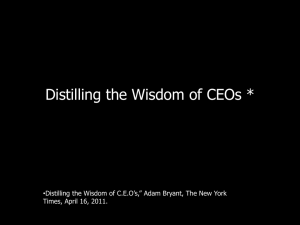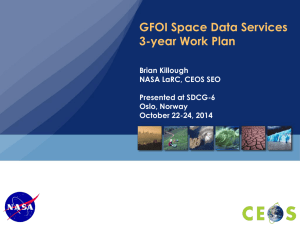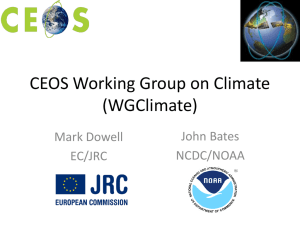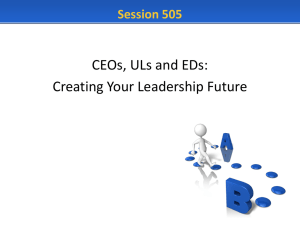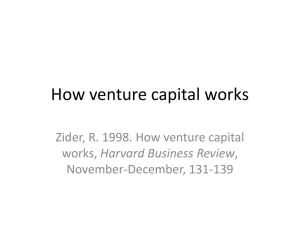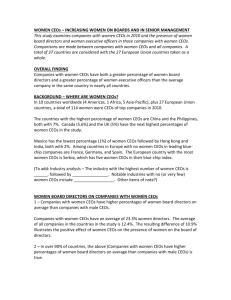CARBON OBS
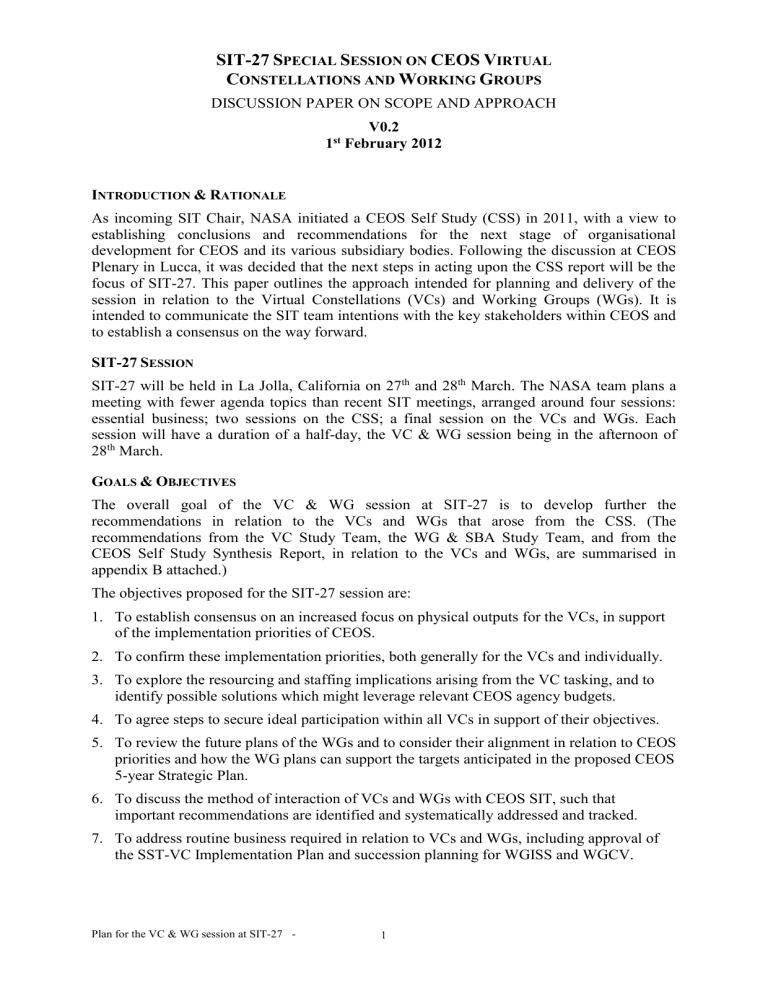
SIT-27 S PECIAL S ESSION ON CEOS V IRTUAL
C ONSTELLATIONS AND W ORKING G ROUPS
DISCUSSION PAPER ON SCOPE AND APPROACH
V0.2
1 st February 2012
I NTRODUCTION & R ATIONALE
As incoming SIT Chair, NASA initiated a CEOS Self Study (CSS) in 2011, with a view to establishing conclusions and recommendations for the next stage of organisational development for CEOS and its various subsidiary bodies. Following the discussion at CEOS
Plenary in Lucca, it was decided that the next steps in acting upon the CSS report will be the focus of SIT-27. This paper outlines the approach intended for planning and delivery of the session in relation to the Virtual Constellations (VCs) and Working Groups (WGs). It is intended to communicate the SIT team intentions with the key stakeholders within CEOS and to establish a consensus on the way forward.
SIT-27 S ESSION
SIT-27 will be held in La Jolla, California on 27 th
and 28 th
March. The NASA team plans a meeting with fewer agenda topics than recent SIT meetings, arranged around four sessions: essential business; two sessions on the CSS; a final session on the VCs and WGs. Each session will have a duration of a half-day, the VC & WG session being in the afternoon of
28 th
March.
G
OALS
& O
BJECTIVES
The overall goal of the VC & WG session at SIT-27 is to develop further the recommendations in relation to the VCs and WGs that arose from the CSS. (The recommendations from the VC Study Team, the WG & SBA Study Team, and from the
CEOS Self Study Synthesis Report, in relation to the VCs and WGs, are summarised in appendix B attached.)
The objectives proposed for the SIT-27 session are:
1.
To establish consensus on an increased focus on physical outputs for the VCs, in support of the implementation priorities of CEOS.
2.
To confirm these implementation priorities, both generally for the VCs and individually.
3.
To explore the resourcing and staffing implications arising from the VC tasking, and to identify possible solutions which might leverage relevant CEOS agency budgets.
4.
To agree steps to secure ideal participation within all VCs in support of their objectives.
5.
To review the future plans of the WGs and to consider their alignment in relation to CEOS priorities and how the WG plans can support the targets anticipated in the proposed CEOS
5-year Strategic Plan.
6.
To discuss the method of interaction of VCs and WGs with CEOS SIT, such that important recommendations are identified and systematically addressed and tracked.
7.
To address routine business required in relation to VCs and WGs, including approval of the SST-VC Implementation Plan and succession planning for WGISS and WGCV.
Plan for the VC & WG session at SIT-27 -
1
A
PPROACH
& S
CHEDULE
The NASA SIT Team will work with VC & WG leads ahead of the SIT-27 meeting to ensure preparation of the necessary materials for a productive session. The proposed approach is:
1.
To utilise this paper as the focus for a discussion with stakeholders on the outcomes and approach to the session [initial discussions can be held at the CEOS-GEO actions meeting on 14 th and 15 th February].
2.
SIT Chair will lead a series of telephone calls with VC Leads and WG Chairs in February to hear feedback on the proposals and to secure their support in preparing for SIT-27. A group call will be held with all VC Leads and WG Chairs to allow discussion and exchange of ideas in preparing for SIT-27 [February].
3.
NASA SIT team will develop discussion with individual VCs and WGs through to SIT-
27, with an emphasis on specific implementation targets for each, and associated staffing and resourcing needs and solutions. CEOS SEC will be informed via the regular SEC telcons. [During February and March]
4.
SIT Chair will arrange and host a half-day workshop on 26 th
March (am), the day before
SIT-27, to confirm the preliminary conclusions with regards to VC & WG implementation priorities, and to make final preparations to the content for the session with CEOS
Principals on 28 th
March.
5.
The SIT-27 session will define actions for the SIT Team to take forward, including with all stakeholders, and especially the VC Leads and WG Chairs. The target is to have all
CSS recommendations in relation to the assignment of VCs and WGs, and the associated membership, resourcing and reporting issues, concluded by the end of 2012. SIT Chair will provide a status report to CEOS Plenary in October in India. The SIT Workshop in
Sept 2011 offers a further opportunity to consult with VC Leads and WG Chairs.
D
ISCUSSION
VCs focusing on physical outputs and implementation: Much of the discussion within
CEOS in recent months has assumed that it's a foregone conclusion that circumstances are such that the VCs must adopt a stronger focus on physical outputs and implementation support to the main CEOS and GEO priorities. The CSS Self Study process certainly indicated a willingness on the part of most VC leads for this to be the case, but a caveat that the resourcing model and skill set of the VCs would have to change. The SIT Team will consult with VC leads at the earliest opportunity to confirm their support for the call within the community to refocus the VCs.
Initial implementation targets: Consultations arising from the CSS effort, identified two areas where the implementation targets for the VCs should initially be directed:
ECV coordination support to the WGClimate and the Climate Architecture, as a topic which requires coordination on multiple timescales, successfully combines research and operational missions, and is appealing to many CEOS space agencies; the pilot efforts of the SST-VC team in 2012 are intended to indicate how this might be approached; the priorities within WGClimate and the schedule envisioned for the Climate Architecture need to be understood and should be reported to SIT-27.
Plan for the VC & WG session at SIT-27 -
2
Support to the physical delivery requirements resulting from current and emerging CEOS priorities, including FCT, GFOI, CEOS Carbon Strategy, GEO-GLAM and others. It is recognised that CEOS is not set up to handle operational data delivery, but most of these initiatives will stay in pre-operational phase for some time and the VCs are the best vehicle available to CEOS in support of the data delivery needs; a good example is to determine the on-going role of the LSI in support of the strategy being developed by the
GFOI Space Data Coordination Group, and mechanisms for development of the datasets being developed in the coming years, prior to emergence of an operational institutional framework.
The context and role of the VCs in supporting ECV coordination ambitions for the
WGClimate and the Climate Architecture was illustrated in the VC report to the CSS, and repeated below.
Preliminary thoughts on the implementation targets for each of the VCs and WGs are provided in Appendix A attached here, and will form the starting point for the discussions between SIT Chair and the various VCs and WGs.
Resourcing and staffing : VC leads are understandably nervous that what is essentially an overtime activity will escalate into a heavier undertaking, with real delivery demands but no new resources for their achievement. An integral part of the realignment of the VC objectives must be a frank assessment of the resources and skills required. CEOS is a best efforts organisation and is typically fuelled by the coordination budgets available to staff responsible for international affairs. The new order envisioned for the VCs is likely much more relevant to budgets available for dataset and product development within space agencies (and other bodies) and CEOS must identify how to leverage these budgets and engage the relevant staff skills if we are to be successful. ESA has established its Climate Change Initiative precisely for this purpose and SIT must explore how to leverage this and its equivalents elsewhere in order to find ‘new’ sources of funds for these collective ambitions expressed through CEOS.
Plan for the VC & WG session at SIT-27 -
3
The way in which the SST-VC has sought to ‘design in’ the expertise and funding to allow it to undertake ECV assessment and development may provide a template for evolution of the other VCs. The SST-VC has engaged relevant experts with funding from various funded
ECV/CDR development activities, such as the SST ECV programme within ESA’s CCI (and others within NASA and NOAA). Linkage with leading science groups such as GHRSST also guarantees access to the necessary expertise. First milestones in relation to the ECV development and anticipated by the VC within 12-24 months.
VC Representation : SIT Chair has already taken steps to address ideal participation in the various VCs by CEOS space agencies – inviting all Chinese Members of CEOS to consider providing representatives. The effort in 2012 will include support to VC leads to capture the new representation that is needed to address the implementation targets. SIT Chair team will also provide a monthly report to CEOS SEC on behalf of the VC leads (as recommended by the VC CSS team, similar to that provided by WG Chairs).
WG alignment : The CSS recommended that CEOS develop a 5-year Strategic Plan, supported by short-term work plans. As an input to this plan, and in order to encourage further alignment of the WGs with overall CEOS objectives, a set of strategic objectives for each of the four WGs should be developed in discussion with the WG Chairs. The development of these objectives should draw on both CEOS’s overall strategic thrust, as well as plans that the
WGs already have in place. An approach and schedule will be formulated in light of and consistent with the overall Strategic Plan development and outcomes.
N
EXT
S
TEPS
The NASA SIT Team will refine the objectives and approach outlined in the paper in consultation with the various CEOS stakeholders. VC Leads and WG Chairs will be approached in the near future to arrange the series of telcons with SIT Chair.
Plan for the VC & WG session at SIT-27 -
4
APPENDIX A
S ETTING I MPLEMENTATION T ARGETS F OR T HE VC S & WG S
The newest of the VCs, the SST and OCR teams, have support to the Climate Architecture
‘designed in’ – both VCs have confirmed their intention to support the coordination of ECV assessment and generation, with a new WG being established in OCR for that purpose. So it is already a reality that the next phase of the CEOS Virtual Constellation development will support realisation of the Climate Architecture. The objective of the SIT Chair team is to ensure that, by the end of 2012, all of the VCs and WGs are aligned in that direction and contributing to the Climate Architecture, and to the physical delivery requirements resulting from current and emerging CEOS priorities. The CEOS Self Study proposed a stronger focus on physical delivery by CEOS, and the VCs and WGs are the instruments available to CEOS to achieve that.
The implementation targets selected for each VC/WG should reflect:
CEOS priorities, including those identified by WGClimate for the Climate Architecture;
The domain expertise of the VC or WG – the target must naturally reflect their scope and abilities.
Initial discussions with the WGClimate indicate the following possible targets, which also reflect the ambitions raised in the course of the CEOS Self Study. There are purely for discussion at this stage:
CEOS VC
SST
OCR
OST
ECVs
Sea Surface Temperature
Ocean Colour
Sea Level
Notes
VC plan specifically targets ECV/CDR generation. SST-VC could be used as a pilot study for ECV assessment and implementation.
VC plan specifically targets ECV/CDR generation. Very positive symbiotic relationship with IOCCG, which is in process of establishing standing WG on ECV assessment.
Potentially excellent example combining the
VC with the OST Science Team, as with OCR.
OSVW Wind Speed and Direction OSVW has been very focused on operational needs.
PC
LSI
Precipitation
Land Cover, FAPAR, LAI,
Albedo
Not currently within mandate but interested to discuss possibility.
Not currently within mandate. Uncertainty around role in support of GFOI/FCT to be resolved. Support from WGCV Land Products
Validation Subgroup should be investigated as source of expertise and resources.
Plan for the VC & WG session at SIT-27 -
5
ACC Ozone (Aerosols) ACC in process of discussing possibility of taking on Ozone ECV responsibility - currently undecided. ACC doesn't currently have adequate representation to address aerosols.
Note the suggestion to explore support to LSI from the WGCV LPV SG. There may be other
WGCV Subgroups that can be called upon in support of other VCs (eg the Atmospheric
Composition Subgroup may be able to assist ACC with their ECV activities.
In addition to Climate Architecture support, the VCs and WGs will be asked to identify how they can support physical delivery for the current and emerging CEOS priorities. The current status and outlook for each of these priorities is summarised in the table below, as the basis for initial discussions:
CEOS Priority Status & outlook
GFOI/FCT
Carbon
Strategy (CTF)
GEO-GLAM &
JECAM
Supersites
GEO Water
Strategy
GEOBON
Pre-operational phase. Ongoing coordination of global acquisitions is needed
(handled by SDCG). The role of the FCT Product Development (PD) teams is being significantly overhauled due to lack of institutional support. There is an opportunity for the LSI to play an important role in this process, by supporting physical delivery of national datasets to the National Demonstrators – demonstrating the potential of GFOI and the utility of the ongoing acquisitions.
LSI could lead the delivery of the ND datasets identified as priorities for 2012
(for one or more countries).
Planning phase. The CEOS Carbon Strategy will be published in late 2012 or early 2013 and will provide a framework for the realisation of the Integrated
Carbon Observations and Analysis system characterised in the GEO Carbon
Strategy Report. Implementation actions will be needed from 2013 to progress the realisation of the Strategy, and these may be relevant to many or all of the
VCs. It is premature to discuss VC support.
Planning Phase. GEO-GLAM is still developing requirements and a strategic implementation plan. Physical delivery support from CEOS is very much anticipated, and will include a space data coordination role – which may require an expansion of the planning put in place for the GFOI SDCG. It is premature to discuss VC support, but it would be a logical extension of LSI support to GFOI.
The need for VC support may evolve rapidly in 2012 and CEOS should stay abreast of developments. JECAM is already underway and may have shorter term need around product development and delivery that LSI could potentially address.
Supply of data is already underway within the Supersites initiatives, with the PIs undertaking the development of products and analysis. No obvious implementation support role is foreseen for the VCs or WGs. This should be confirmed.
Planning Phase. The team that developed the IGOS IGWCO report intends to bring the report up to date (following the process followed for the IGOS Carbon
Report) during 2012 and 2013 – resulting in a GEO Water Strategy Report. The prospect of CEOS engagement and response to this process is being formulated.
Implementation support needs will arise but it is premature to identify what they will be as yet. The Precipitation Constellation is an obvious candidate to support the activity; expansion of the PC to a broader Water Cycle Constellation is a possibility to seek to address more variables. This is for future discussion.
Planning Phase. Requirements are still being defined. Premature to discuss implementation support.
Plan for the VC & WG session at SIT-27 -
6
Of these, the only immediate and obvious requirement is the application of LSI expertise and resources in support of the delivery of one or more high profile datasets in 2012 for the
GFOI/FCT National Demonstrators – with LSI playing a role in the reformulation of the PD team arrangements to bring stronger institutional base for physical delivery goals around
GFOI/FCT. This is an important and relevant role for LSI to play.
APPENDIX B
CEOS S
ELF
S
TUDY
T
EAM ON THE
V
IRTUAL
C
ONSTELLATIONS
R EPORT R ECOMMENDATIONS
1.
The Constellations are the main tool through which CEOS pursues domain-specific coordination. Participation by key CEOS data provider agencies is not universal in the
Constellation teams and should be tackled directly.
2.
Four of the seven Constellation teams are in support of ocean observations and some prioritisation process may be needed to ensure a future balance of effort is guaranteed – consistent with CEOS priorities. This may be provided by the engagement proposed with
WGClimate and possibly the Climate Architecture, amongst others.
3.
Constellation partnerships between research and operational space agencies have significantly strengthened the prospects for continuity of observations and this model should be taken into account in future planning of new Constellations. The willingness to embrace a comprehensive coordination framework through the Climate Architecture may provide a path for effective engagement of both research and operational space agencies, and their respective coordination bodies, in Constellation activities and objectives.
4.
To realise its full potential as an implementation mechanism for the GEOSS, the
Constellations efforts should give greater emphasis to the physical results of coordination
– the ‘sharp end’, such as data products and ECVs. There is an immediate demand for such implementation support – aiding the ECV inventory and coordination efforts of the
WGClimate. This will require real resources and may require additional membership for
Constellation teams.
5.
The SST-VC has volunteered to serve as a pilot for the demonstration of the implementation partnership between Constellations and WGClimate.
6.
As the Climate Architecture effort evolves from a badgeless activity to considering which existing assets and processes might be engaged or adapted in support of the functional and physical architectures, the role for the Constellations should be carefully considered.
7.
The Constellations address a range of different coordination and implementation issues, reflecting the diversity of real-world challenges for CEOS in realising the space segment of the GEOSS. Any change in terms of reference or to the Constellations Process Paper should recognise the value of such diversity and not ‘over-standardise’ in a way which might restrict contribution of the Constellations to CEOS objectives.
8.
The SIT process and meetings should be redesigned to identify, and escalate as appropriate, important outputs from the Constellations which have implementation
Plan for the VC & WG session at SIT-27 -
7
implications, and to guarantee debate between Principals with supporting observation programmes.
9.
It is beyond the scope of this study to consider the effectiveness of the Constellation recommendations, through CEOS, in influencing the mission budgeting and programming decisions of individual space agencies. It has been noted however that agencies need a goal to subscribe to that reflects their national policies and requirements and the
Constellations have made progress this direction. Their attention to ECVs may provide a focus to which agencies and governments can subscribe and communicate back home to implement programming decisions.
10.
The Constellation teams should have more direct representation on the CEOS SEC meetings to ensure that Constellation-related business stays on the management radar throughout the year. This could be via a nominated representative responsible for collating and distilling inputs from the Constellations to SEC.
11.
Constellation teams have catalogued their planned outputs for the next few years in the course of this CEOS Self Study. CEOS should review this output and determine whether these achievements reflect the organisation’s ambitions. A dialogue between SIT Chair and Constellations to this end would be a logical next step.
CEOS S ELF S TUDY T EAM ON W ORKING G ROUPS AND SBA S
R
EPORT HIGHLIGHTS IN RELATION TO
WG
S
1.
Finding: WGISS and WGCV have changed from bottoms-up R&D arrangements to contributing to CEOS satellite arm of GEOSS; however, integrally contributing activities are still formulated largely by the WGs with much autonomy. WGs respond to Tasks and
Actions assigned from SIT/CEO.
2.
Finding: WGs lateral internal (other WGs, SBAs, VCs) and external coordination (GEO multiple Committees and Tasks, IGOS, etc.) has grown.
CEOS S ELF S TUDY S YNTHESIS REPORT
R
EPORT HIGHLIGHTS IN RELATION TO
VC
S
& WG
S
RECOMMENDATION #4: CEOS should develop a concise, yet complete, 5-year Strategic
Plan and a schedule for review and update of future Strategic Plans. The Strategic Plan should be accompanied by appropriate Work Plans to ensure progress toward established goals. The plan should not only consider GEO Work Plan goals, but should address primary CEOS goals, and it should contain inputs from the CEOS Constellations, Working Groups, and SBA
Teams.
RECOMMENDATION #9: Strengthen working relationships among Working Groups, SBA
Coordinators, and VCs to support common CEOS objectives around high-level CEOS initiatives and their cross-WG/SBA synergies, rather than on a project-by-project (or even
SBA-by-SBA) basis. Encourage the CEO and DCEO and other leadership as appropriate to attend WG meetings to help communicate CEOS priorities on a cross-WG and cross-SBA basis. Utilize the CEOS website more effectively for lateral CEOS communications and initiative/task coordination across Working Groups, SBAs, and VCs. Rebalance the task load
Plan for the VC & WG session at SIT-27 -
8
to more effectively utilize and leverage existing resources.
RECOMMENDATION #13: CEOS Working Groups, Constellations and SBA Teams should address the lack of participation by providing a list of strongly desired space agencies and associates to the CEOS SIT. CEOS Principals can be made aware of their desired participation in Constellation efforts and the anticipated gain from such participation. If participation continues to be too low to sustain necessary Constellation activities, CEOS leadership should work with the WG, VC, or SBA Co-chairs to identify and address the reasons.
RECOMMENDATION #15: The CEOS Plenary and/or SIT meetings should provide sufficient time for consideration of Working Group, Virtual Constellation, and SBA Team priorities and recommendations together with strategic discussion and direction to these groups on their annual work. Working Groups, Virtual Constellations and SBA teams should be encouraged to more specifically measure and document their progress in relation to
CEOS’s highest priorities. In turn, CEOS leadership should actively participate in establishing priorities for the Working Groups, Constellations, and SBA Teams by reviewing these initiatives and gathering feedback from the SEC and SIT to reach decisions.
Plan for the VC & WG session at SIT-27 -
9
